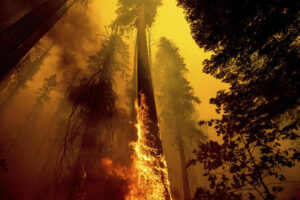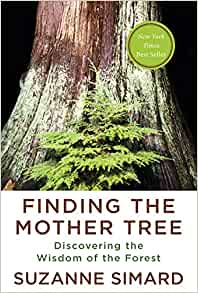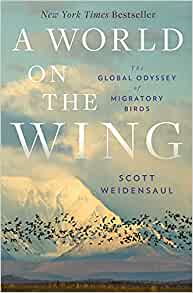Finding the Mother Tree
The Mother Trees
October 9, 2021CBS
Northern California wildfires may have killed hundreds of giant sequoias as they swept through groves of the majestic monarchs in the Sierra Nevada, an official says.
“It’s heartbreaking,” said Christy Brigham, head of resource management and science for Sequoia and Kings Canyon national parks.
The lightning-caused KNP Complex that erupted on Sept. 9 has burned into 15 giant sequoia groves in the park, Brigham said.
More than 2,000 firefighters were battling the blaze in sometimes treacherous terrain. On Wednesday afternoon, four people working on the fire were injured when a tree fell on them, the National Park Service reported.
The four were airlifted to hospitals and “while the injuries are serious, they are in stable condition,” the report said. It didn’t provide other details.
The KNP Complex was only 11% contained after burning 134 square miles of forest. Cooler weather has helped slow the flames and the area could see some slight rain on Friday, forecasters said.
The fire’s impact on giant sequoia groves was mixed. Most saw low- to medium-intensity fire behavior that the sequoias have evolved to survive, Brigham said.
However, it appeared that two groves – including one with 5,000 trees – were seared by high-intensity fire that can send up 100-foot flames capable of burning the canopies of the towering trees.
That leaves the monarchs at risk of going up “like a horrible Roman candle,” Brigham said.
Two burned trees fell in Giant Forest, which is home to about 2,000 sequoias, including the General Sherman Tree, which is considered the world’s largest by volume. However, the most notable trees survived and Brigham said the grove appeared to be mostly intact.
In one grove, Dickman counted 29 sequoias that were “just incinerated,” he told CNN.
“There were four of those that had burned so hot that they’d fallen over,” he said.
The 152-acre fire was 75% contained.
cbsnews.com
Highly recommend:
Imagine if Zuckerberg and the media spent as much energy and time covering the climate emergency, our planet, our dear Gaia, as they do the former president and hateful, divisive rhetoric. Imagine. Two senators, two, tied to fossil fuel and special interests, dark money, may proclude our ability to change this awful climate trajectory. Zero compassion for Earth and humanity’s future. They. Do. Not. Care. Only power, greed, self-interest. I live in Idaho. Our elected leaders do not represent their constituents, only the GOP and their lobbyists. They will do nothing. -dayle
“Then shall all the trees of the forest sing for joy before the Lord.
1 Chronicles 16:33
Unfolding catastrophe.
June 5, 2021Social media post by Tzeporah Berman on May 27th:
“Please…just….please act now. This should be illegal. I saw stumps of 1000 year old trees with flagging tape on 2000 year old yellow cedars. It’s like destroying Pantheon or the Sistine Chapel to make a buck. Enough already.”
Tzeporah lives in Vancouver and is the International Program Director for https://www.stand.earth. She is also an adjunct professor at York University and the chair for Fossil Fuel Non-Proliferation Treaty…https://fossilfueltreaty.org
Fresh Air
May 4th, 2021
Trees Talk To Each Other. ‘Mother Tree’ Ecologist Hears Lessons For People, Too
Trees are “social creatures” that communicate with each other in cooperative ways that hold lessons for humans, too, ecologist Suzanne Simard says.
Simard grew up in Canadian forests as a descendant of loggers before becoming a forestry ecologist. She’s now a professor of forest ecology at the University of British Columbia.
Trees are linked to neighboring trees by an underground network of fungi that resembles the neural networks in the brain, she explains. In one study, Simard watched as a Douglas fir that had been injured by insects appeared to send chemicalwarning signals to a ponderosa pine growing nearby. The pine tree then produced defense enzymes to protect against the insect.
“This was a breakthrough,” Simard says. The trees were sharing “information that actually is important to the health of the whole forest.”
In addition to warning each other of danger, Simard says that trees have been known to share nutrients at critical times to keep each other healthy. She says the trees in a forest are often linked to each other via an older tree she calls a “mother” or “hub” tree.
THIS:
[Trees] get old. They do eventually decline. And dying is a process, and it takes a long, long time. It can take decades for a tree to die. In the process of dying, there’s a lot of things that go on. And one of the things that I studied was where does their energy — where does the carbon that is stored in their tissues — where does it go? And so we label some trees with carbon dioxide — with C13, which is a stable isotope — and we watched as we actually cause these trees to die. We stress them out by pulling their needles off and attacking them with budworms and so on. And then we watched what happened to their carbon.
And we found that about 40% of the carbon was transmitted through networks into their neighboring trees. The rest of the carbon would have just dispersed through natural decomposition processes … but some of it is directed right into the neighbors. And in this way, these old trees are actually having a very direct effect on the regenerative capacity of the new forest going forward.
This is a completely different way of understanding how old trees contribute to the next generations — that they have agency in the next generations. And our practices of salvage logging to get rid of dying trees, or trees that have just died or have been burned in wildfires — if we go in and cut them right away, we’re actually short-circuiting that natural process.
Full interview with Dave Davies/NPR’s Fresh Air:
One of the books recommended by President Barack Obama in conversation with the NYTimes Ezra Klein:
“A book I just read, “The Overstory” by Richard Powers, it’s about trees and the relationship of humans to trees. And it’s not something I would have immediately thought of, but a friend gave it to me. And I started reading it, and it changed how I thought about the earth. And it changed how I see things, and that’s always, for me, a mark of a book worth reading.”
Full interview: https://www.nytimes.com/2021/06/01/opinion/ezra-klein-podcast-barack-obama.html
Eight trees were destroyed in May in name of capitalism and concrete next to my place in Sun Valley, Idaho. Unnecessary. And tragic. All were mature, healthy trees. When will we stop? Will we ever? -dayle
‘Unless someone like you cares a whole awful lot,
nothing is going to get better. It’s not.’ -The Lorax
NPR/Dave Davies
Naturalist Traces The ‘Astounding’ Flyways Of Migratory Birds
Did you know that when some migratory birds prepare for flights that can take them thousands of miles, their intestines and digestive organs actually shrink while their heart, lung and leg muscles can double in size? That’s just one of the amazing facts you can learn from our guest, Scott Weidensaul. He spent decades studying migratory birds, reporting on and writing about them and doing fieldwork and tracking and conservation efforts. The scale of bird migration is staggering, involving billions of birds, and the diversity of the species’ mating, nesting and flying habits is awe inspiring. In a new book, Weidensaul writes about what he calls this majestic global pageant and about the threats the animals face. One study found that since 1970, roughly 30% of North American birds have disappeared, more than 3 billion of them. Scott Weidensaul has written 30 previous books, and his articles have appeared in Audubon, National Wildlife and other publications. He co-founded Project SNOWstorm, which tracks and studies snowy owls and is a founder of the Critical Connections project, which is tracking the migration of birds that breed on national park lands in Alaska. His new book is “A World On The Wing: The Global Odyssey Of Migratory Birds.” He joins us from his home in Milton, N.H.
https://www.npr.org/2021/03/29/982232107/naturalist-traces-the-astounding-flyways-of-migratory-birds








